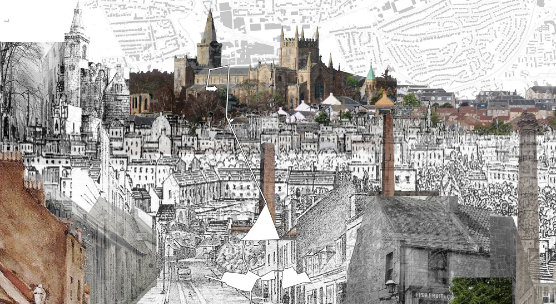Degree Show seeks to tackle Scotland’s housing challenges
Published On Mon 23 May 2016 by Grant Hill

How would a Manhattan-inspired block work beside the Edinburgh by-pass? How do we make homes energy-autonomous? How can urban sprawl and planning legislation be reconciled? What can be done to ensure the housing needs of vulnerable members of society are met?
These are some of the pressing social questions that Architecture graduands from the University of Dundee have been grappling with over the past year and their proposed solutions are currently being exhibited at the 2016 Degree Show.
Forty-nine graduating students are displaying their work at Degree Show along with students from years 1-4 of the Architecture programme and graduands of the University’s Duncan of Jordanstone College of Art and Design.
“Our students have created a fantastic body of work which addresses specific real-world problems while also looking at more theoretical ways of reimagining our relationship with housing,” said Helen O'Connor, Head of Architecture and Planning.
“They have looked at contemporary issues in living and housing – whether relating to sustainability, planning, affordability and others – and come up with a range of solutions ranging from the practical to the radically abstract. Their exhibits, along with those of the students from other years, show how Dundee continues to produce some of the country’s best young architects.”
The final-year students worked in one of four units designed around projects specific to the housing needs of Scotland.
Those on Unit 1 examined the pioneering renewable energy system on the Isle of Eigg and, working with students and tutors from Physics and other areas of the University, considered how houses can be both energy-autonomous and meet the changing needs of families. While the proposals they came up with are specifically designed for Eigg, the principles can be transferred to any Scottish rural setting.
Unit 2 students looked at theoretical ways of helping the central belt to cope with the massive population growth predicted to take place over the next 50 years. This largely centred on introducing density to a suburban context and the idea of building a high-rise street block by the Edinburgh bypass is one of the most stark and thought-provoking exhibits on display.
Students who chose to work on the third unit considered how specific user groups can be assimilated into communities while ensuring their particular housing needs were being met. The groups the students chose to look at included dementia sufferers and people struggling with addiction and mental health problems.
Unit 4 challenged the students to look at a specific site – Broomhill Estate in Dunfermline – as a way of exploring the major planning issues that arise around urban sprawl. They looked at innovative ways of meeting the needs of new suburban communities and the desire for good quality family housing.
Helen added, “Final-year students have the enthusiasm, imagination and intellectual capacity to bring their fresh ideas to the issues facing the contemporary built environment. We took the opportunity this session to highlight how we live in Scotland and the problems we might face – social exclusion, space standards, environmental change and the loss of green space – to imagine alternative solutions.”
Almost 300 graduands are exhibiting at the Art, Design and Architecture Degree Show 2016. Admission is free and the show if open from 10am until 8pm (Monday – Friday) and 10am to 4pm (Saturday – Sunday) until Sunday, 29th May.
More information is available at http://www.dundee.ac.uk/djcad/degreeshow/.
For media enquiries contact:
Grant Hill
Press Officer
University of Dundee
Nethergate, Dundee, DD1 4HN
Tel: +44 (0)1382 384768
Mobile: 07854 953277
Email: g.hill@dundee.ac.uk